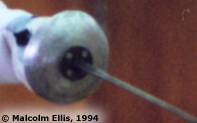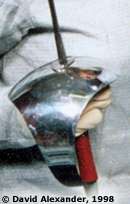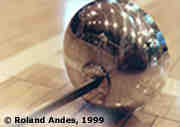












|

There are three different fencing weapons: sabre, foil and epee.
Foil
| The foil
was the original fencing weapon. A hit is scored when the point
of the blade contacts the opponent's torso.
To record the touch electronically, each fencer wears a sleeveless
metallic vest, the "lamé" (pronounced la-may), which defines
the target area. The electric
scoring equipment uses a coloured light to show the referee
who has been hit "on target". Hits anywhere outside the target
zone are "off target", and set off a white light. They don't score
but do stop the action. |
|

|
 |
|
A hit
can only be scored by the fencer who has "priority".
Priority is initially taken by the fencer who begins the attacking
action.
A defender, before earning the right to score, must successfully
defeat the attack (done by retreating or by deflecting the attack
with a "parry") and responding with the reply (the riposte). This
riposte takes priority over the other fencer's original attack.
These simple actions build to complicated exchanges. After each
exchange resulting in a hit, the referee stops the action, adjudicates
to determine who had priority, and awards any point scored. |
Sabre
 |
|
The sabre
was originally the fighting weapon of the cavalry, and was designed
for use on horseback. However, the modern fencing sabre has a
much thinner blade than a military sword. A sabre fencer scores
hits by cutting the opponent with the edge or by thrusting with
the point to score a touch. (Foil and epee use the point only).
"Target" for sabre is all the body above the waist. As with foil,
sabre fencers wear a lamé jacket, though for sabre the jacket
is long sleeved, and connected to the mask by a wire to complete
the target area.
Again like Foil, the electric
scoring equipment uses a coloured light to show the referee
who has been hit "on target". However, unlike foil with its "off
target" white lights, hits anywhere outside the sabre target zone
are not recorded. They don't score and do not stop the action.
Sabre, like foil, has rules determining the priority of hits,
adjudicated by the referee. The attacker has the right to score.
A defender, before earning the right to score, must parry, then
riposte. |
Epee
| The epee
(pronounced e-pay, with a short "e" - as in "epic",
rather than "email") derives from the duelling sword
of the 19th century, the epee de combat ("sword of combat").
It is the heaviest of the three weapons.
The entire body is target for the epee - from the toe to the
mask. Simulating the duel, opponents often try to reach the nearest
target - the hand, arm or the foot.
There are no rules governing right of way in attack or defence.
Scores are recorded when the point of the blade hits any part
of the body: the first fencer to hit scores. If both fencers hit
within 4/100th of a second, they both score. The electric
scoring equipment indicates the hit with a coloured light
showing who has scored. |
|

|
|

